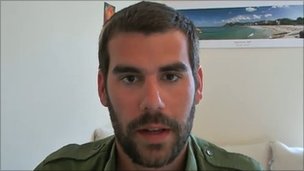The British 9/11 Truther, Charlie Veitch, has recanted. He reportedly changed his mind after a demolitions expert explained to him why the Twin Towers could not have been brought down by controlled demolitions. He was friends with Alex Jones and David Icke, and he had his won website. Since he announced his change of mind, he has received death threats, and both he and his mother have received harassing e-mails.
The Telegraph has an interesting article about Veitch that is worth reading in its entirety. One of the more interesting passages tells how Veitch became a Truther:
- And at six o’clock one morning, after a night out at a club, it pounced.
“I was absolutely spangled from the nightclub when my best friend said ‘Charlie, you know you’re Right-wing and you joined the Army? Well, they were lying to you.’ I’m like, ‘What?’ He said, ‘9/11; it wasn’t as you think.’ It was almost like an initiation into a cult, a religion. You’re being given special knowledge.”
Truthers have often seemed to me to be almost like religious cultists. The idea of a 9/11 conspiracy is like a revealed truth to them. And it’s one that can seem empowering. Somebody who has never even taken a calculus course can suddenly become an expert on structural engineering, pedantically lecturing other people on controlled demolitions and what a hole left by an airplane looks like.
What’s interesting is how the 9/11 conspiracy theories have begun to bleed over into other more bizarre theories held by people such as Jones and Icke. A conspiracy theory can be like a rabbit-hole. Having embraced an idea that most people reject, the conspiracy theorist begins to associate only with other like-minded people. Eventually he or she learns about the Bilderburg Group, the New World Order, and the Illuminati, until finally the seeker is initiated into the ultimate mystery: shape-shifting reptilian overlords from another dimension.
CounterPunch readers who want to believe that anti-Semitism is not a problem may want to read this part:
- In essence, the modern conspiracy narrative is the same as the one that has existed since at least the 19th century: that the few (often termed the “Illuminati”) control the many. This, of course, is the nucleus of the dangerous anti-Jewish myth. When he was an insider, did he experience anti-Semitism? His eyes open wide: “Loads. Loads. I was once accused of being a Jew because of my olive skin and my nose. They said, ‘We can’t trust him’.” And when they say the ‘Illuminati’ or ‘Reptiles’, do they actually mean Jews? “It’s slightly complicated but, mostly, yes,” he says.
This article in Slate is also worth reading.





